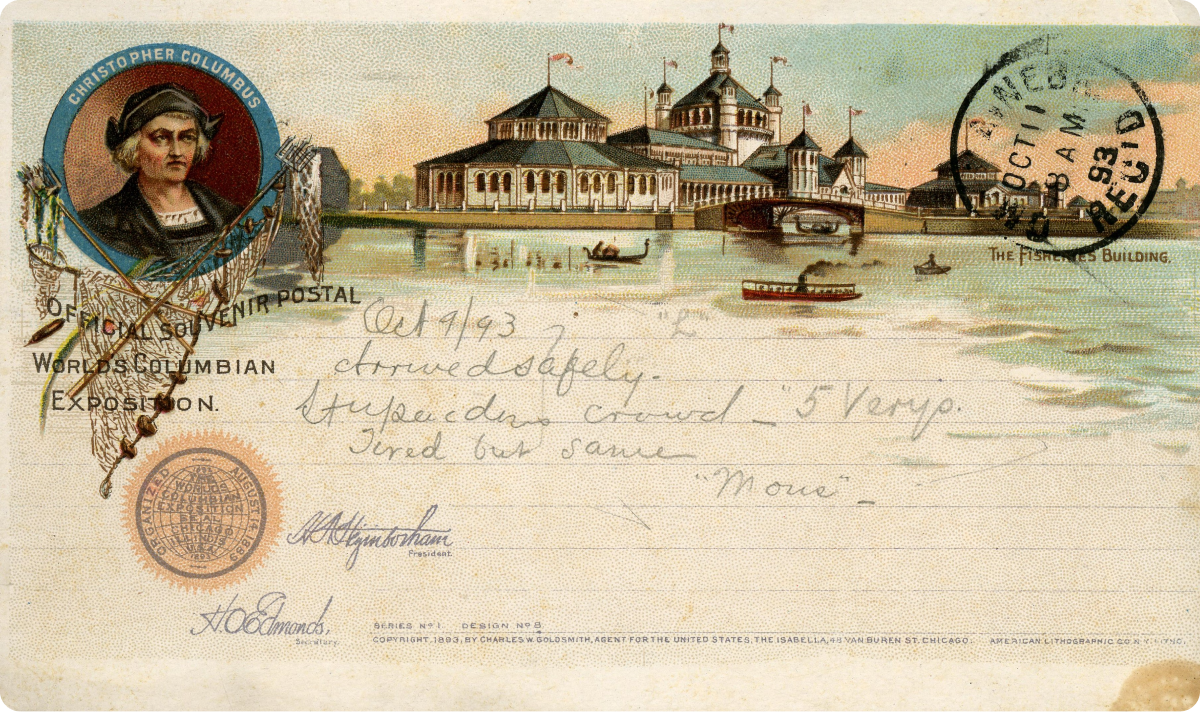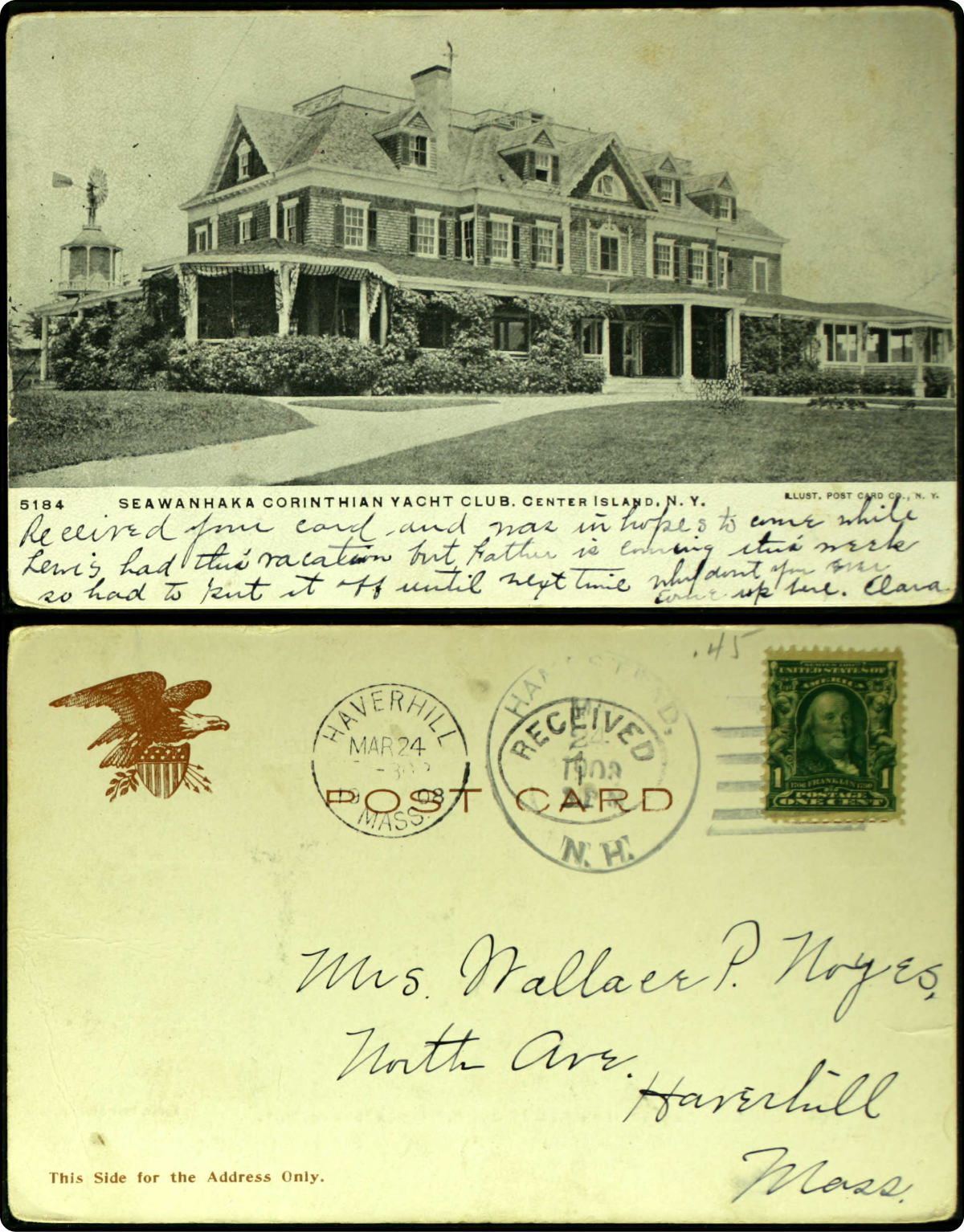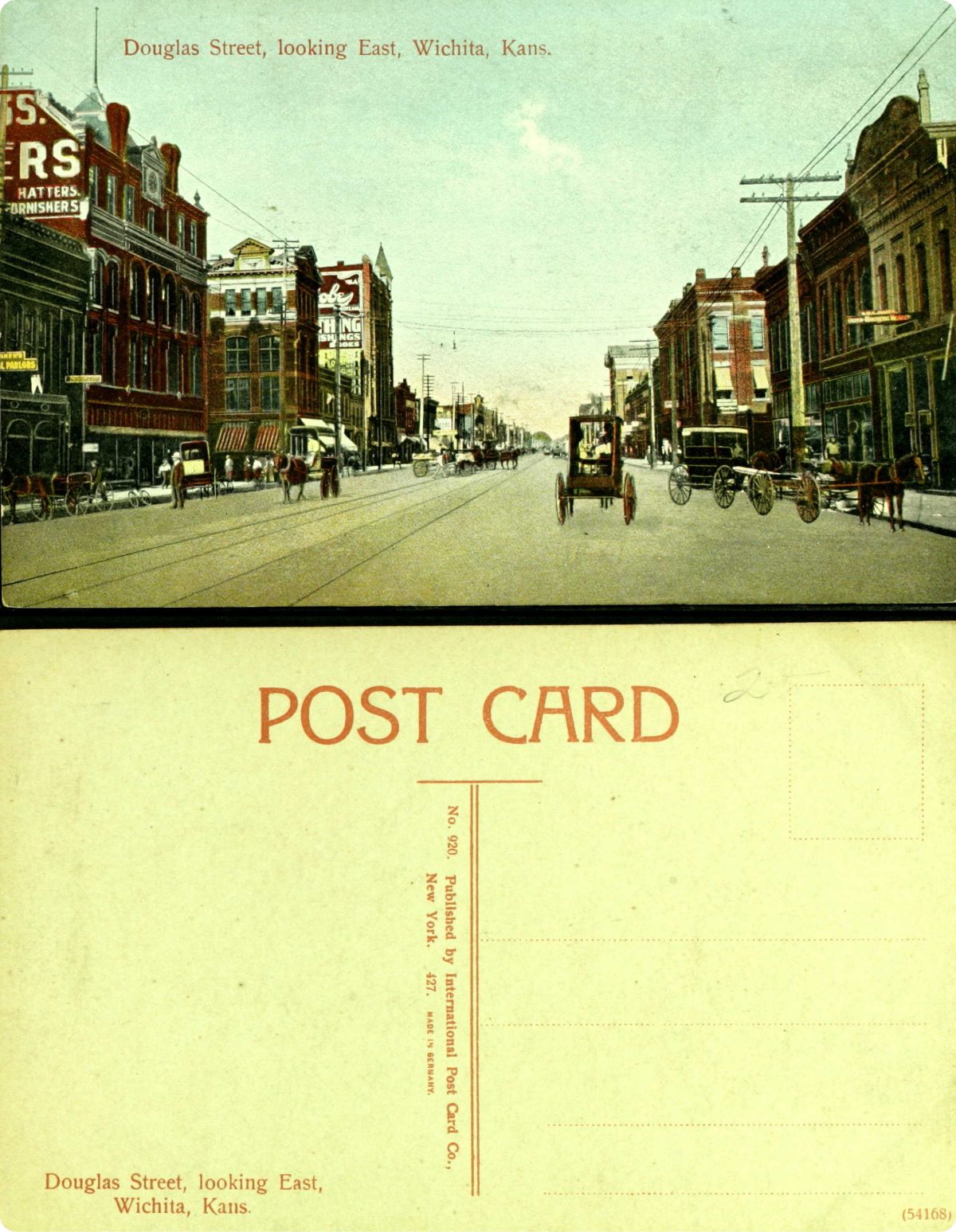There’s a reason you find so many old postcards for sale in antique shops: they’re not only vintage reminders of times past, but they are packed with useful information for anyone interested in history. From the choice of photograph or illustration on the front to the contents of the message on the back, postcards can tell us a lot about our ancestors.
The Golden Age of Deltiology
In the 21st century we have our choice of communication media, from email to texting to thank-you cards. But until the telegraph revolutionized communication in the mid-19th century, paper mail was the dominant form of staying in touch.
It didn’t come cheap. Postage amounts were determined in the post office according to the number of pages in the letter and the distance it needed to travel, making the sending and receiving of mail a luxury for most working people.
It was only in the second half of the 19th century that national postal services began to explode in popularity, thanks to one innovation, first suggested by the British mathematician, polymath, and “grandfather of modern computing,” scientist Charles Babbage. A man who liked to solve national problems as a hobby, Babbage turned his attention to the Royal Mail for a little while in the 1830s and came up with a brilliant and counterintuitive suggestion for making the mail more accessible and widely-utilized: flat postage rates. Babbage crunched the numbers and discovered that most of the postal service’s expenses were not spent on delivery, but on paying all those postmasters and clerks to weigh and analyze the mail. By creating a flat rate for postage, millions more people began using the mail and their business more than made up for losing a few higher postage rates. The United Kingdom and the United States adopted the flat rate in the mid-19th century and both countries saw their postal services explode in popularity.
In the United States, the phenomenal success of the 1893 World Columbian Exhibition (a.k.a., the Chicago World’s Fair) extended to the postcard, which became a popular memento of the spectacular event. Those commemorative postcards offered civic boosters around the country a new form of promotion for their local attractions. In 1897 the U.S. Postal Service actually lowered the cost of mailing a postcard domestically, from letter rate (2 cents) to one penny. With this, a true craze for deltiology (the sending and collecting of postcards) began.
Many factors contributed to the explosion of deltiology both in the U.S. and Europe. Low postage rates helped, but so did innovations in photography and printing that allowed detailed, beautiful renderings of people and places, as well as the expansion of small business distribution networks, which brought postcards to the masses in general stores, newsstands, and even upscale department stores.
1905-1915 is considered the Golden Age of Postcards. One major change was the USPS’s decision in 1907 to allow half of the back of the postcard (the other side of the picture) to be used for a personal message--up to this point, senders had to write on top of the picture on the front! Providing more room for actual communication turned the postcard into a more than just a decorative keepsake. In the nineteen-teens, Americans mailed hundreds of millions of postcards every year. It was a cheap, easy way to stay in touch with family or keep a memento of a special trip.
For historians, postcards can be an amazing resource not only for reading the mail of our ancestors but also for understanding what our ancestors thought was important or interesting enough to be memorialized on a card. From Vatican City to the World’s Biggest Ball of Twine, postcards can be solemn or humorous, meaningful or frivolous. And even with the advent of digital communication technology, postcards continue to thrive.
Weekly Discoveries
A Jewish historical photo expert will speak in the free virtual presentation, “Clued-In: Interpreting Real Photo Postcards from the Diaspora."
World War II Hero's Lost Postcard Finds Its Way To His Family After 78 Years!
Did you survive Covid? Maybe you can thank your Neanderthal ancestors
Kentucky Historical Society launches “Kentucky Ancestors” television program
Why You Should Always Mail Yourself a Postcard When Traveling
Wish You Were Here!: Postcards, Our Windows to the Past
Old postcards are oftentimes part of the ephemeral effects found in the boxes, trunks or attics of the dearly departed and they can provide not only great context to the lives of our ancestors, but they may also provide clues or starting points for continuing research.
During the late-19th and early-20th centuries, postcards were extremely popular. They were essentially the equivalent of modern-day text messaging. Cards depicted everything from vacation destinations to holiday and birthday celebrations, as well as landmarks and modes of transportation. The images, messages, addresses and postmarks included on the postcards tell a story, if you know how to analyze them sufficiently. An understanding of the history and evolution of postcards can prove quite beneficial in deciphering the not-so-apparent clues.
Begin by determining when the postcard was published. A general understanding of the style evolution of American postcards, which can be broken down into eight general time periods, can prove very helpful in this regard.
Pioneer Era (1893-1898) - Though postcards were first introduced in the 1860s, some of the earliest postcards in existence were created for the Chicago World’s Fair (World’s Columbian Exposition) in 1893. During the exposition, they were sold by vendors and exhibitors for attendees to collect or send to family and friends. During this time period, there were two main types of postcards, the “Souvenir Card” and the “Mail Card.” The latter was printed by the United States government and included 1-cent postage printed directly on the card, while the former were printed by private companies and required that a 2-cent adhesive postage stamp be affixed. In neither type were messages allowed to be written on the address side of the postcards.
Private Mailing Cards Era (1898-1901) - Requiring a 1-cent adhesive stamp, the United States Congress passed an act granting private printing companies the permission to print and sell cards that included the phrase “Private Mailing Card.” During this time a dozen, or more, printers were printing American postcards. During this time period, messages written on the address side of the cards were still prohibited.
Post Card Era - Undivided Back (1901-1907) - Government-issued cards had the words “Postal Card” printed on the address side, while a regulation imposed on 24 December 1901 required that cards printed by private companies include the words “Post Card” on the address side.
Real Photo Postcards (1900-present) - First produced around the turn of the 20th century, real photo postcards are replications of actual photographs. Under magnification, a smooth transition from tone to tone will be evident, in contrast to the characteristic dot pattern of the “Chrome” postcards developed almost four decades later.
Divided Back Era (1907-1915) - Prior to this time, all messages were relegated to the front image side of the postcard, with the back reserved solely for the address of the recipient. Though Britain began dividing the backs of the postcards to include a space for a written message, it wasn’t until 1 March 1907 that the United States began permitting the printing of the divided-back cards. This time period was considered the golden age of postcards, with many millions being published. Most postcards printed for the American consumer had been printed in Germany prior to this, but with World War I looming, publication moved to England, then America.
White Border Era (1915-1930) - The switch to American-published cards led to lesser-quality cards being printed, due to high labor costs and materials. In an effort to save ink, publishers began leaving a clear border around the image, leading to the term “White Border” cards.
Linen Era (1930-1945) - The evolution of printing processes allowed for changes in the medium in which cards were printed. Printers began using a stock with a high cotton rag content, which created a line-like finish. Bright colorful inks, oftentimes paired with a white border, were characteristic of this era. Though the technology had changed, these cards were still considered to be cheaply manufactured.
Photochrom Era (1939-present) - First introduced in the Union Oil Company service stations in 1939, these postcards normally include the word “chrome” somewhere in, or near, the publisher information. Commonly depicted scenes on these cards include automobiles, restaurants, entertainment venues, hotels, and the like. Photochrome postcards can be distinguished from real photo postcards by the dot pattern which can be viewed when magnified, resulting from this unique process, as well as a “slick” finish.
Some of the major postcard publishers printed numbers on their postcards, such as Curt Teich and Detroit Publishing Company which can indicate the publication year. The size of the postcard can also be an indication of the time period in which it was published
If a publisher number or postmark date is not present or illegible, the postage amount can also be an indicator of the time period of a postcard. Though there were some differences, such as those of the Pioneer Era, with government-printed cards requiring 1-cent postage and those privately-published requiring 2-cent postage.
Look to the image itself for clues. The style of clothing that the individuals in the photo were wearing can be very telling, look to sources such as Fashion-Era and Historical Emporium for guidelines on the distinguishing characteristics of clothing styles by time period.
Historical postcards can add context to personal histories, as they show details/images about the place where your ancestors lived or historical events that your ancestor may have been affected by.. No need to rely solely on postcards found in your family papers, collections, such as this U.S postcards collection, which includes over 115,000 cards, or the Library of Congress.
-------------------------
Once you have compiled all of the facts and contextual information, you should write your family history narrative ensuring that you writing in a manner that is pertinent to your target audience.
Past Issues You’ll Love
Have You Lost Your Census? - Read Here
Freedmen’s Bureau Impact - Read Here
“Ye Olde” American Printing Press - Read Here
POTUS on TV - Read Here
The Genealogy of Health - Read Here
New Year, New You, New Ancestors - Read Here
Why We Map - Read Here
Are You a Good Ancestor? - Read Here
Field Guide: Decoding Old Cemeteries - Read Here
Sources…Duh!
Smithsonian Institution Archives ([https://siarchives.si.edu/ : accessed 18 February 2021), “Greetings from the Smithsonian A Postcard History.”
The New York Public Library, (https://digitalcollections.nypl.org/ : accessed 18 February 2021), “Digital Collections: Postcards.”
United States Postal Service (https://about.usps.com/ : accessed 18 February 2021), “Stamps and Postcards.”
The Irish Times (https://www.irishtimes.com/ : accessed 18 February 2021), “In the Age of Babbage.”
Wikimedia Commons, database with images (https://commons.wikimedia.org/wiki/File:The Fisheries Building, World's Columbian Exposition, Chicago, Illinois, 1893.jpg : 18 February 2021), photo of original artwork “File:1890 Census Hollerith Electrical Counting Machines Sci Amer.jpgFile:The Fisheries Building, World's Columbian Exposition, Chicago, Illinois, 1893.jpg;” photograph uploaded by user Extabulis.
“U.S., Historical Postcards, 1893-1960,” database with images, Ancestry.com (https://ancestry.com : accessed 18 February 2021), Seawanhaka Corinthian Yacht Club, Center Island, New York; citing Mary L. Martin, LTD, Havre de Grace, Maryland.
“U.S., Historical Postcards, 1893-1960,” database with images, Ancestry.com (https://ancestry.com : accessed 18 February 2021), Douglas Street, looking East, Wichita Kansas; citing Mary L. Martin, LTD, Havre de Grace, Maryland.
Center of Southwest Studies, Fort Lewis College (https://www.fortlewis.edu/: accessed 18 February 2021), “Tips for determining when a U.S. postcard was published.”
Greta Bahnemann, Minnesota Digital Library (https://mndigital.org : 18 February 2021), “Format Highlights: Postcards,”
The Internet’s Most Random
👀 💎 Click Here






